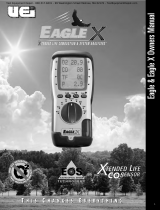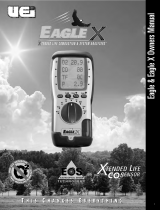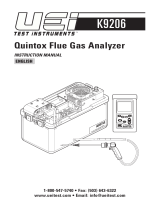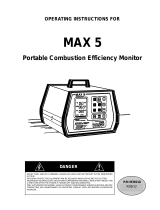Page is loading ...

C o m b u s t i o n m a d e e a s y
Instruction Manual
Smart Bell PlUS
Combustion Meter

TABLE OF CONTENTS
Getting Started
Safety ................................................................................................... 1
SettingTemperature Scale ............................................................... 1
Setting Inlet Temperature ................................................................1
Selecting Fuel .....................................................................................1
Analyzer Connections ....................................................................... 2
Overview..............................................................................................2
Maintenance
General Maintenance ....................................................................... 3
Service & Calibration ........................................................................ 3
Water Trap ..........................................................................................3
Changing Particle Filter ....................................................................3
Battery Replacement ........................................................................4
Electromagnetic Compatibility .........................................................4
Combustion Information
Why test with the Smart Bell PLUS? .............................................. 5
Acceptible Results .............................................................................6
Combustion Basics ............................................................................7
Ideal vs. Real World Combustion ....................................................8
Perfect Combustion Chart ................................................................ 9
Measurment Terms ......................................................................... 10
Glossary
Selector and Display Parameters .................................................11
Meter Problem Solving ................................................................... 12
Meter Specifications .......................................................................13
Warranty............................................................................................14

Safety NoteS
Before using this meter, read all safety information carefully. In this manual the word “WARNING” is used to indicate
conditions or actions that may pose physical hazards to the user. The word “CAUTION” is used to indicate conditions or
actions that may damage this instrument.
WARNING!
This analyzer extracts combustion gases that may be toxic in relatively low concentrations. These gases are exhausted
from the back of the instrument. This instrument must only be used in well-ventilated locations.It must only be used by
trained and competent persons after due consideration of all the potential hazards.
GettiNG Started
• Cleanparticlefilter
• Watertrapandprobelineareemptyofwater
• Poweronandzero
• Allhoseandthermocoupleconnectionsareproperlysecured
• FluegasprobeissamplingambientFRESHair
• Watertrapisfittedcorrectlytotheinstrument
• Fluetemperatureplugisconnected-Onlyifsettinginlettemperature
SettiNG temperature Scale
Tochangethetemperaturescalefrom°Fto°C(orback)performthefollowingsteps;
•StartwiththeSmartBellPLUSOff
•Rotatetheselectorto“˚F/˚C”
o The current scale will initially be displayed
o The unit will switch to the alternative scale
•Rotatetheselectortothedesiredfuelforyourtesting
•Allowtheunittocompletethezeroprocess
Note: These steps are only required one time, or when the scale needs to be changed.
SettiNG iNlet temperature
To correctly calculate net temperature and combustion efficiency it is important to have the correct inlet tempera-
ture set. Two methods are available to properly establish the inlet temperature
• Non-ductedsystems.IftheSmartBellPLUSisbeingusedonasystemthatusescombustionairfromthespace
neartheappliancesimplyturntheanalyzeronwithouttheflueprobeconnected.TheSmartBellPLUSwilluseanambi-
ent sensor inside the handset as the inlet temperature to determine net temperature.
• Ductedsystems.IftheSmartBellPLUSisbeingusedonasystemthatbringsinoutsideairforcombustionairit
is important to set the inlet temperature prior to taking flue gas readings. To properly set inlet perform the following steps
during startup.
1.ConnectthefluetemperatureconnectoronlytotheSmartBellPLUS
2.Placetheflueprobeinthecombustionairinletstream(youwillneedtodrilla1/4”holeforaccess)
3.TurnontheSmartBellPLUSandallowtocompletethezeroprocess.
4.ConnectthefluegasconnectortotheSmartBellandproceedtocombustionmeasurements
•Thetemperaturemeasuredduringthezerocountdownhasnowbeenstored,andwillbeusedtodetermine
the net temperature.
SelectiNG fuel
WhenpoweringtheSmartBellPLUSon,simplyrotatetheselectortothedesiredfuel.Thedisplaywillshowthisdisplay,
and then it will complete the zero process.
Note:Ifyouwishtousethesamefuelaspreviouslyselectedrotatetheselectorto“StandBy”atpoweron.Thefuelinuse
will be displayed and then blink. If the fuel is not correct rotate the selector to the proper choice before the Zero
countdown starts.
OWNERS MANUAL & MAINTENANCE
1

aNalyzer coNNectioNS
NOTE: Take care when inserting the temperature
probes as the pins are polarized. Insert with the smaller pin into input
markedpositive.(+)
WARNING!
Turning the pump off while the probe is in the flue
will leave toxic gases inside the analyzer. Once data
has been read, it is advisable to purge the
unit with fresh air as soon as possible. To do this,
with the probe removed from the flue, turn ON the
pump. Always allow the readings to return to zero
(0.0forCO2)priortoshuttingtheunitoff.
WARNING!
Theprobewillbehotfromfluegases.Removetheprobefromtheflueandallowittocoolnaturally.Do
not immerse the probe in water, as this will be drawn into the analyzer and damage the pump and sensors. Once the
probe is removed from the flue and the readings have returned to ambient levels rotate the selector
to“OFF”.Theinstrumentwillcountdownfrom30toswitchoff.
fiNiShiNG up
• Remove the probe from the flue and allow the analyzer to purge with fresh air until readings return to zero.
-CO2to0.0%,COtoZero(Be careful as the probe tip will be HOT)
• Drainwatertrap
• Checkparticlefilter
• Rotateselectorto“OFF”
NOTE:Toprotectthesensor“HIGH”willbedisplayedandthezerocountdownwillrepeatuntil
COmeasuredislessthan20ppm.
SmartBell pluS overview
OFF
L
O
i
l
P
r
o
p
a
n
e
N
a
t
G
a
s
H
O
i
l
W
o
o
d
S
t
a
n
d
b
y
C
O
C
O
2
O
2
X
-
A
i
r
T
F
l
u
e
E
f
f
˚
F
/
˚
C
˚C ˚F
0000
LCD Display
Selector
Dial
Water
Trap
Fuel/Test Type
Indicator
2

GeNeral maiNteNaNce
•Checkcalibrationofyourinstrumentannuallytoensureitmeetsoriginalperformancespecifications
•Keepyourinstrumentdry.Ifitgetswet,wipedryimmediately.Liquidscandegradeelectroniccircuits
•Wheneverpractical,keeptheinstrumentawayfromdustanddirtthatcancauseprematurewear
•Althoughyourinstrumentisbuilttowithstandtherigorsofdailyuse,itcanbedamagedbysevere
impacts. Use reasonable caution when using and storing the meter
periodic Service
WARNING!
Repair and service of this instrument is to be performed by qualified personnel only. Improper repair or
service could result in physical degradation of the instrument. This could alter the protection from personal
injurythismeterprovidestotheoperator.Performonlythosemaintenancetasksthatyouarequalifiedtodo.
aNNual re-caliBratioN
While the sensors have an expected life of more than five years in normal use it is recommended that the
analyzerisre-calibratedannually.Thisissothatlong-termdriftcanbeeliminated.Localregulationsmay
require more frequent re-calibration and users should check with appropriate authorities to ensure compliance
with relevant guidelines.
cleaNiNG
Periodicallycleanyourinstrumentscaseusingadampcloth.DONOTuseabrasive,flammableliquids,
cleaning solvents, or strong detergents as they may damage the finish, impair safety, or affect the reliability
of the structural components.
emptyiNG & cleaNiNG the iN-liNe water trap
The in-line water trap should be checked and emptied on a regular basis. Water vapor will condense in the
probe line, which may cause the water trap to fill suddenly if the probe is moved. Care should be taken
at all times.
Carefully un screw the plug from the bottom
ofthewater-traphousing.Disposeofthecondensatein
a suitable drain, care must be taken as it could be acidic.
If condensate spills onto the skin or clothing, clean off
immediately using fresh water, seek medical advice
ifproblemsoccur.Ensureplugisreplacedbefore
performing combustion tests. Note: CO2 reading will
belowiftheWaterTrapPlugisnotinplace.
chaNGiNG the particle filter
This is a very important part of the analyzer and should be changed regularly. It prevents dust and dirt
particlesfromenteringthepumpandsensorsthatwillcausedamage.ThefilterMUSTbechangedwhen
it appears discolored on the inner surface.
Remove water-trap assembly from the analyzer
as shown above. Remove the filter and plastic
holderfromthehousing.Discardthefilter
element but keep the holder to fit to the new
filter. Clean the inside of the filter housing
withasuitablesoftcloth.Fittheholderonto
the new filter element and then insert into the
housing. Refit the housing onto the analyzer.
Hook slides
out of dock
Slide outward
Unscrew plug
to drain
3
Insert a new filter

BatterieS replacemeNt
This meter has been designed for use with alkaline
batteries. No other types are recommended. The analyzer
issuppliedwith4“AA”sizealkalinebatteries.
These should be installed into the instrument as shown
in the diagram to the right and indicated on the back of
the unit.
CAUTION!
Take great care when installing the batteries to observe
correct polarity. Always check the meter for operation
immediately after installing new batteries.
electromaGNetic compatiBility (emc)
This product has been tested for compliance with the
following generic standards:
EN50081-1,EN50082-1andiscertifiedtobe
compliant.
TheEuropeanCouncilDirective89/336/EECrequiresthatelectronicequipmentdoesnotgenerate
electromagnetic disturbances that exceed defined levels and has an adequate level of immunity to enable it to
be operated as intended.
Sincetherearemanyelectricalproductsinusethatpre-datethisDirectiveandmayemitelectromagnetic
radiationinexcessofthestandardsdefinedintheDirectivetheremaybeoccasionswhereitwouldbe
appropriate to check the analyzer prior to use. The following procedure should be adopted.
•Gothroughthenormalstartupsequenceinthelocationwheretheequipmentistobeused
•Switchonalllocalizedelectricalequipmentthatmightbecapableofcausinginterference
•Checkthatallreadingsareasexpected(alevelofdisturbanceinthereadingsisacceptable)
•Ifnot,adjustthepositionoftheinstrumenttominimizeinterferenceorswitchoff,ifpossible,the
offending equipment for the duration of the test
Atthetimeofwritingthismanual(September2011)UEiisnotawareofanyfieldbasedsituationwheresuch
interferencehaseveroccurredandthisadviceisonlygiventosatisfytherequirementsoftheDirective.
Note: Follow battery directions
on back of housing
Battery Compartment
Cover
Back of
Instrument
4

verify proper operatioN of comBuStioN equipmeNt
• Toverifythatequipmentisoperatingasthemanufacturedesignedittowork.Thisincludesinstallation
testsforCO,CO2,O2,ExcessAirandstacktemperatures
- A properly tuned combustion appliance will perform better, and reduce the likelihood of
call-backs for no-heat
• Toverifythatthemaintenanceworkperformedhascorrectedtheproblem
• Todetectanydefectsearly–possiblyatinstallation
-Higherefficiencyequipmentisrunningatpeakonlywhenproperlyadjusted.Asthecomplexity
of a system increases, so does the importance of proper adjustment of the combustion process.
• Improperly adjusted equipment not only fails to meet expected performance but could lead to future failures
• Tocheckthattheequipmentissuppliedwithenoughcombustionair,make-upairandhasproper
venting to exhaust the combustion by-products
• Toestablishabase-lineofdesiredperformance
- By tracking the performance over time you are able to see changes before they lead to
equipment failure.
verify Safe operatioN of comBuStioN equipmeNt
• Equipmentthatisnotproperlyadjusted,orthathasinsufficientdrafttoventcombustiongasescould
produce carbon monoxide in deadly quantities.
• Whencustomerscomplainaboutfumesitisusuallyanindicationofimproperoperation.COisa
colorless, odorless gas so the fumes are not the CO, but an indication that a problem may exist.
improve your productivity & profit
• TheUEiSmartBell pluS combustion meter gives a quick, continuous readout of the combustion process.
Readings change in real-time as adjustments are made to help zero in on the proper setting. Compare
this to spot tests or other methods, and you will see your productivity rise.
• Propertestingwillhelpyouprovidetheproperserviceorequipmentreplacement
recommendations,andhavethedatatosupportthis.Saleswillincreasebecauseyouarenolonger
guessing, and the work provided is proper for the needs of the customer.
• Customersonaservicecontractwillbeprovidedexcellentservice,andyouwillquicklydiagnosefailures
and help keep the equipment up for the season.
improve cuStomer perceptioN of your ServiceS
• Provideyourcustomersresultsoftheperformanceoftheirequipment
• Reduceyourcustomersenergyexpensebyproperlyadjustingandmaintainingtheirequipment
• Increaseyourconfidenceintheworkperformedandremember
if you doN’t teSt, you doN’t KNow
WHY TEST WITH SmartBell pluS™
5

atmoSpheric GaS fired BurNerS
• Oxygen ....................................................................................................6.8to7.9%O2
• Stack Temperature ................................................................................325to500°F
• Draft (WaterColumnInches) .................................................................-.02to-.04wc”
• Carbon Monoxide(partspermillion) ...................................................<100ppm
GaS fired power BurNerS
• Oxygen ....................................................................................................8.5to10.2%O2
• Stack Temperature ................................................................................275to500°F
• Stack Draft (WaterColumnInches) ......................................................-.02to-.04wc”
• Overfire Draft (WaterColumnInches) .................................................-.02wc”
• Carbon Monoxide(partspermillion) ...................................................<100ppm
oil fired BurNerS (#2 oil fuel)
• Oxygen ....................................................................................................10to12%O2
• Stack Temperature ................................................................................325to600°F
• Stack Draft (WaterColumnInches) ......................................................-.04to-.06wc”
• Overfire Draft (WaterColumnInches) .................................................-.02wc”
• Carbon Monoxide(partspermillion) ...................................................<100ppm
• Smoke .....................................................................................................0
(ormanufacturer’srecommendation)
poSitive overfire GaS & oil
• Oxygen ....................................................................................................7to13%O2
• Stack Draft (WaterColumnInches) ......................................................-.02to-.04wc”
• Overfire Draft (WaterColumnInches) .................................................+0.4to+0.6wc”
• Carbon Monoxide(partspermillion) ...................................................<100ppm
co air free – co uNdiluted
Carbon monoxide is easily diluted with additional excess air, and disperses quickly in the presence of additional air. This
characteristic has led to some references of a value that can compare like for like readings.
NewerBPIstandardsreference“COUndiluted”valuesinadditionto“COAsMeasured”.TheSmartBellPlusmeasures
COandcalculatesO2.FromthisinformationitiseasytodetermineCOUndilutedusingthemultiplicationfactorfrom
the following table.
Example:COMeasured–50ppm,O2Calculated–7.2%,Multiplicationfactorfromtable–1.5
COAirFree=COmeasuredxFactor=50ppmx1.5=75ppm
NOTE: Follow manufacturers guidelines for the specific equipment being serviced
WHAT RESULTS ARE GENERALLY ACCEPTABLE
6
O2% Mult. O2% Mult. O2% Mult. O2% Mult.
0.0 ~ 0.9 1.0 12.4 ~ 12.7 2.5 15.7 4.0 17.3 5.9
1.0 ~ 2.7 1.1 12.8 ~ 13.0 2.6 15.8 4.1 17.4 6.0
2.8 ~ 4.1 1.2 13.1 ~ 13.3 2.7 15.9 4.2 17.5 6.1
4.2 ~ 5.4 1.3 13.4 ~ 13.5 2.8 16.0 4.3 17.6 6.3
5.5 ~ 6.4 1.4 13.6 ~ 13.8 2.9 16.1 ~ 16.2 4.4 17.7 6.5
6.5 ~ 7.4 1.5 13.9 ~ 14.0 3.0 16.3 4.5 17.8 6.7
7.5 ~ 8.2 1.6 14.1 ~ 14.2 3.1 16.4 4.6 17.9 7.9
8.3 ~ 8.9 1.7 14.3 ~ 14.4 3.2 16.5 4.8 18.0 7.2
9.0 ~ 9.6 1.8 14.5 ~ 14.6 3.3 16.6 4.9 18.1 7.5
9.7 ~ 10.1 1.9 14.7 ~ 14.8 3.4 16.7 5.0 18.2 7.7
10.2 ~ 10.7 2.0 14.9 ~ 15.0 3.5 16.8 5.1 18.3 8.0
10.8 ~ 11.1 2.1 15.1 3.6 16.9 5.2 18.4 8.4
11.2 ~ 11.6 2.2 15.2 ~ 15.3 3.7 17.0 5.4 18.5 8.7
11.7 ~ 12.0 2.3 15.4 3.8 17.1 5.5 18.6 9.1
12.1 ~ 12.3 2.4 15.5 ~ 15.6 3.9 17.2 5.6 18.7 9.5

iNtroductioN
UEicombustionanalyzersproviderealtimedatathatprovidesinformationontheconditionofthecombus-
tion process of your equipment. This information is needed for proper setup and maintenance to verify proper operation.
Benefits of combustion analysis are to increase efficiency thus reducing fuel costs, verification of proper combustion to
reduce future problems, and to check for safe operation. A combustion process out of balance can increase maintenance
needs, create excess emissions, lead to safety concerns or waste fuel and money. By checking for proper operation you are
able to confirm a job well done.
•Thisoverviewwillexplainsomeofthecommontermsusedincombustiontesting
–Thecombustionprocess–(asmallamountofchemistry)
–Idealcombustion–youmayhaveheardthetermStoichiometric(ornot)
–RelationshipbetweenCO2,COandO2
•Theanalyzeranddisplay
–Varioustextandiconsusedonthefronthousingandinthedisplay.
–Whatwillthereadingsdowhenadjustmentsaremade
–Whereareyouonthecombustioncurvesfromthesereadings
the comBuStioN proceSS
What is really going on during combustion? Most of us know it as a fire that is generating heat and possibly
smoke.Weknowthatpaperorwoodcanburnwhenlit,andcontinuetoburn–butwhatisreallyhappening?
Combustion is a continuous chemical reaction that occurs when a certain temperature is reached, and there is the presence
of both fuel and an oxidizer. The most common fuels are hydrogen and carbon, and the typical oxidizer is O2 present in
the air we breathe. Once the reaction is started it will continue as long as it is being fed fuel and oxygen, and the tempera-
ture is sufficient.
ideal comBuStioN proceSS
Ifaperfectconditioncouldexistforcombustionitwouldbetheburningofpurehydrogen(H2)inpureoxy-
gen(O2).Thiswouldgiveusheatandwater,andbetheeasiesttomaintain.Twohydrogen(H2),combinewithoneO2
molecule gives us two water molecules plus heat. The reaction would be something like figure 1.
It is great in theory that we would have a very efficient system with only some heat losses from the water vapor, but
itisn’tverypractical.Purehydrogenandoxygenareexpensivetocreate,anddifficulttohandlecomparedtoother
fuels already available.
COMBUSTION BASICS
7

Near ideal comBuStioN
This is When we burn pure hydro- gen
intheair.Ouratmosphereis20.9%oxygen with
theremaining79.1%nitrogen.
This is nearly as desirable as the example for ideal
combustion with the only added loss being the
heat that is carried away from your target with
thenitrogen.Becausenitrogenisn’tpartof the
combustion process, it enters the combustion
chamber at the inlet temperature and leaves
with some of the heat created by the combus- tion.
Ifthisisn’trecoveredattheheatexchangeritis lost
up the flue.
The main problem with this example is again the
availability and cost of pure hydrogen.
BeSt of the real world
Natural gas is a
readily available fuel, and our atmosphere
contains sufficient oxygen. When this is
usedasafuelwegetthereaction;shown
in figure 3.
Now the other added outputs are CO2
and hot nitrogen compared to the Ideal
World situation. In addition to this we
haveaddedtheoutputExcessAir.
ExcessAirisexactlywhatthename
implies, air that is in excess of what is
needed to burn all of the fuel. The
reason for this is more related to the
ability to mix all of the fuel and O2 for
complete combustion. Without some
amount of excess air not all of the fuel
would burn completely, and this leads to
the formation of CO instead of CO2.
Other fuels all contain the basic ingre-
dients for combustion, but also may
include other components such as
sulfur, fuel bound nitrogen, soot and
ash and water. These either react with
the oxygen to form other pollutants or
contribute to
additional losses.
Wet Loss
Dry Loss
figure 3
Carbon Monoxide is formed from incomplete combustion (partial oxidation of carbon in
the fuel). Typical causes are incomplete mixing of fuel and air, low combustion temperatures,
or not enough excess air.
8

Wet Loss
Dry Loss
perfect comBuStioN
The term perfect combustion is also called stoichiometric combustion. This is the point where all of the fuel
isburnedwithalltheoxygen,leavingnoundesirablebyproducts.Atthispointallofthehydrogeninthefuel(H2)would
combinewithoxygentoformH2O,allofthecarbon(C)wouldcombinetoformCO2,andallofthesulfur(S)would
formSO2.Therewouldbenoadditionalairtocarryheatawayfromthefire,andnoundesirablebyproductswouldbe
created.Inpracticethisisn’tpossibleduetotheinabilitytocompletelymixthefuelandair,soanadditionalamountofair
is used to completely burn the fuel.
Thechartinfigure4illustratestherelationshipbetweenthemainfluegascomponentsthatprovideanindicationofthe
performance of the combustion process.
As you move left to right you are going from a rich to lean condition. The term Air rich is equivalent to fuel lean, and
simply indicates a situation where the excess air is much higher.
To adjust the combustion process you are given the best overall picture of the condition by measuring all three parameters.
Eachoftheparametersperformsdifferentlyasyoumovethroughtheadjustmentofacombustionprocess
CO2–Thisisthegasthatwasmostcommonlyusedforadjustingcombustionequipment.Atoolcalled
an Orstat, or wet chemical kit would give you a snapshot of the CO2 value. As you can see by the graph,
CO2ismaximizedwhentheprocessisrunningatperfectcombustion.Becausethisisn’tpossible,thegoal
has always been to maximize CO2. The trouble is that this can occur at two places in the graph, once on
the fuel rich side, and once on the fuel lean side. A smoke test is used to first place you on the
right side of the graph, and then CO2 was maximized to reach the highest value possible.
2. O2 is the next gas that is measured. At perfect combustion all of the O2 in the atmosphere is consume
so very little remains in the flue gases. If you adjust with this gas you are more certain to be on the correct
sideofperfectcombustion,butyoumaystillbecreatingcarbonmonoxide(CO)duetoinsufficientlevelsof
O2 to completely burn the carbon in the fuel. This may lead to sooty buildup, reducing efficiency, but you
are also not extracting all of the energy the fuel has to offer.
3.CarbonMonoxide(CO)isthelastgaslisted.AsyoucanseeontheleftsideofthechartCOproduction
is the highest. At ideal combustion this level is the lowest possible, but if the other gas measurements are not
available you may be adding too much excess air leading to losses in efficiency. Also if the amount of air being
fed to the combustion process is increased too high it may start cooling the combustion chamber down and
begin creating CO. Once you are at this point without measuring O2 or CO2, you may instinctively add
more O2 to reduce the CO level and end up creating more.
figure 4
9

other importaNt factorS relatiNG to comBuStioN
•ThethreeT’sofcombustion
–Time
•Amountoftimethatthefuelandoxygenaretogetherinthecombustionchamberandhotgasesareinthe
heat exchanger
–Temperature
•Howhighthetemperatureisdeterminestherateofoxidation,orspeedofthecombustion
–Turbulence
•Howwellthefuelandairaremixed
•Thesethreefactorsareallinterrelated,andwillmoveyourresultsalongthecombustioncurves.
comBuStioN meaSuremeNt termS
Other parameters measured include net temperature, draft and efficiency.
Net Temperature
Net temperature is the difference between the combustion air entering the combustion chamber and the flue gas tem-
perature past the heat exchange. This is used to determine how efficient the system is extracting heat from the combus-
tion process in addition to the performance of the combustion process. On sealed systems that have ducted inlet air for
combustion air, the net temperature must compare this air stream temperature with the flue gases. If the appliance simply
uses room air for the combustion air, our analyzers have an internal temperature sensor in the handset, so it will use this
temperature when calculating net temperature.
Themostaccurateresultsforefficiencyareobtainedwhenmeasuringfluegasesatthepointwherefluetemperature(not
flametemperature)isthehighest.
Draft
Draftisthedifferencebetweentheambientpressurelevelandthepressurelevelintheflue.Thisiscreatedeitherbythe
natural buoyancy of the hot gases created in combustion, or by an inducer fan that assists the flow of flue gases up the
stack. Most combustion equipment will specify the amount of draft that is required for proper operation.
Drafthelpsdrawcombustionairintothecombustionchamber,andalsohelpsinmixingthefuelandoxygen.Without
proper draft, the combustion process can spill poisonous byproducts into the space where the appliance is located. This
can be a risk to those in the area, or create a danger to residents or employees working near the combustion equipment.
Efficiency
Efficiencyisameasureofhowwellthefuelisburnedtocreateheat,andhowwellthegeneratedheatiscapturedforthe
intended use.
The information used to create this value are based on the fuels heating value, the heat lost up the flue and the gas
components in the flue gas. The original method to determine efficiency included many manual methods and lookup
charts. As an example you would measure the CO2 level and the stack temperature and then reference a slide scale that
wouldgiveyoutherelativeefficiencynumber.UEi’selectroniccombustionanalyzersperformthemeasurementsona
continuous basis, and can calculate the efficiency as adjustments are being made. With this information you are able to
provide a before and after comparison of the combustion equipment in relatively little time as part of normal servicing.
NOTE: Combustion analyzers measure the combustion and heat exchanger efficiency. This is NOT the same as the AFUE indi-
cated by the manufacturer. The AFUE is derived through an extensive process, and includes many additional parameters such as
start-up and shut-down losses and shell losses as an example.
10

Selector aNd diSplay parameterS oN uei SmartBell pluS
“ZeRO”–Analyzerisperformingtheinitialzerosetting
CO(CarbonMonoxide)–Directreadingofthecarbonmonoxidesensordisplayedinpercent-
age(%)
CO2(CarbonDioxide)–Directreadingofthecarbondioxidesensordisplayedinpartsper
million(ppm)
O2 (Oxygen)–O2iscalculatedforeachfueltypefromtheCO2measurement.It
assumes that the combustion process is running fuel lean. It is important to make other
measurements to confirm that this assumption is always correct.
X-Air (ExcessAir)–ExcessAiriscalculatedforeachfueltypefromtheCO2measure-
ment. It assumes that the combustion process is running fuel lean. It is important to
make other measurements to confirm that this assumption is always correct.
TFlue (FlueTemperature)–TFlueisadirectmeasurementofthetemperatureatthetip
of the flue probe. This measurement is used to determine the net temperature for use in
calculation of combustion efficiency.
Eff(Efficiciency)–Calculatedcombustion(notappliance)efficiencybasedonmeasurements
ofCO2,FlueTemperatureandfuelselected.TheSmartBellcalculatesgrosscombustion
efficiency and automatically determines if the combustion is in the condensing mode to make
appropriate corrections.
BAT symbol-DisplaystheBatterypoweravailable.
HIGH Displaysatstandby/poweroffifCOlevelsaregreaterthan20ppm.
NOTE: If turning unit off countdown will resume once CO levels are lesser
than 20ppm.
Fuels Available
GLOSSARY
11
Selector Position Display Type
L Oil LOIL Light Oil
Propane PrOP Propane
Nat Gas n6AS Natural Gas
H Oil HOIL Heavy Oil
Wood vOOd Wood

METER PROBLEM SOLVING
If any problems are not solved with these solutions, contact us or an authorized repair
center.
Fault symptom Causes / Solutions
CO or CO2 too low • Air leaking into probe, tubing, water trap
or connectors.
CO2 reading (- - - -) • Meter was stored in a cold environment and
is not at normal working temperature.
Batteries not holding charge • Batteries exhausted.
Meter does not respond to flue gas • Particle filter blocked.
• Probe or tubing blocked.
• Pump not working or damaged with
contaminants.
Net temperature or Efficiency • Ambient temperature set wrong during
calculation incorrect. Automatic Calibration.
Flue temperature readings erratic • Temperature plug reversed in socket.
• Faulty connection or break in cable or plug.
T flue displays (- - - -) • Probe not connected or faulty
X-Air, EFF display • CO2 reading is too low.
(- - - -)
12

parameter reSolutioN accuracy raNGe
Gas MeasureMent
Carbon Monoxide *1 1ppM ±5ppM <100ppM 0-1999ppM
±5% rdg >100ppM
Carbon dioxide *1 0.1% ±0.2% reading 0-30%
oxygen *2 0.1% ±0.3% reading 0-21%
CalCulations
effiCienCy *2 0.1% ±1.0% reading 0-99.9%
exCess air *3 0.1% ±0.2% 0-250%
teMp MeasureMent
flue TeMperaTure 1.0 ˚f ±(2% rdg + 3.6˚f) 32-1112 ˚f
±(2% rdg + 2˚C) (0-600˚C)
pre-proGrammed fuelS naTural gas, lighT oil, propane, Wood, heavy oil.
DiMensions (approxiMaTe)
WeighT 1 lb
handseT 7” x 2” x 31/4”
probe 4” x 1/4” sTainless sTeel shafT
noMinal 36” neoprene hose.
aMbient operatinG ranGe +32o˚f To 104˚f
10% To 90% rh non- Condensing
850 To 1100 MMhg aTMospheriC pressure
battery life 4 aa Cells
>8 hours using alkaline aa Cells
*1 using dry gases aT sTp
*2 CalCulaTed
*3 CalCulaTed assuMing fuel lean CoMbusTion.
meter SpecificatioNS
(NOTE MAY BE SUBJECT TO CHANGE)
13

SmartBell pluS comBuStioN meter™ limited warraNty
The SmartBell pluS Combustion Meter is warranted to be free from defects in materials and workmanship
foraperiodoffiveyears(10yearsensorlifeexpectancy)fromthedateofpurchase.Ifwithinthewarranty
period your instrument should become inoperative from such defects, the unit will be repaired or replaced
atUEi’soption.Thiswarrantycoversnormaluseanddoesnotcoverdamagewhichoccursinshipmentor
failure which results from alteration, tampering, accident, misuse, abuse, neglect or improper maintenance.
Batteries and consequential damage resulting from failed batteries are not covered by warranty.
Any implied warranties, including but not limited to implied warranties of merchantability and fitness for
aparticularpurpose,arelimitedtotheexpresswarranty.UEishallnotbeliableforlossofuseoftheinstru-
ment or other incidental or consequential damages, expenses, or economic loss, or for any claim or claims for
such damage, expenses or economic loss. A purchase receipt or other proof of original purchase date will be
requiredbeforewarrantyrepairswillberendered.Instrumentsoutofwarrantywillberepaired(whenrepair-
able)foraservicecharge.Returntheunitpostagepaidandinsuredto:
8030SWNimbusAvenue,BeavertonOR97008
ForreturmauthorizationandaservicenumbercontactUEiorvisitusonline.
CALL:1-800-547-5740•FAX:(503)643-6322
www.ueitest.com•Email:[email protected]
This warranty gives you specific legal rights.
You may also have other rights which vary from state to state.
USA: 1.800.547.5740 • Fax: 503.643.6322
CANADA: 1-877-475-0648 • Fax: 604.278.8299
WWW.UEiTEST.COM
COPYRIGHT © 2011 UEi. Smart Bell PLUS Combustion Meter™ is a trademark of UEi.
Z 8/11 18323??
14
/







